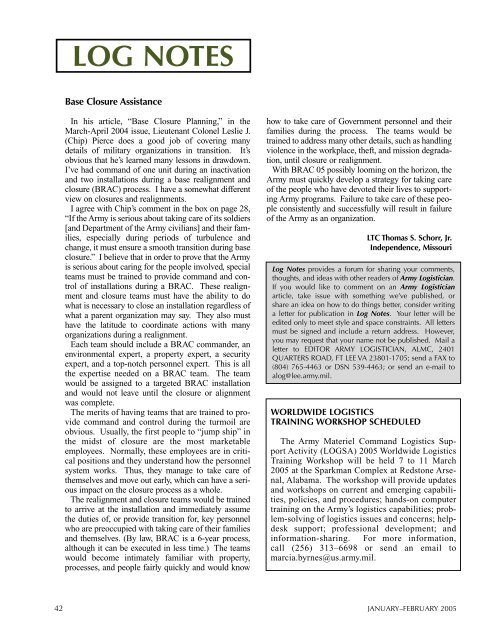Supporting the First Stryker Brigade in Iraq - Army Logistics ...
Supporting the First Stryker Brigade in Iraq - Army Logistics ...
Supporting the First Stryker Brigade in Iraq - Army Logistics ...
You also want an ePaper? Increase the reach of your titles
YUMPU automatically turns print PDFs into web optimized ePapers that Google loves.
42<br />
LOG NOTES<br />
Base Closure Assistance<br />
In his article, “Base Closure Plann<strong>in</strong>g,” <strong>in</strong> <strong>the</strong><br />
March-April 2004 issue, Lieutenant Colonel Leslie J.<br />
(Chip) Pierce does a good job of cover<strong>in</strong>g many<br />
details of military organizations <strong>in</strong> transition. It’s<br />
obvious that he’s learned many lessons <strong>in</strong> drawdown.<br />
I’ve had command of one unit dur<strong>in</strong>g an <strong>in</strong>activation<br />
and two <strong>in</strong>stallations dur<strong>in</strong>g a base realignment and<br />
closure (BRAC) process. I have a somewhat different<br />
view on closures and realignments.<br />
I agree with Chip’s comment <strong>in</strong> <strong>the</strong> box on page 28,<br />
“If <strong>the</strong> <strong>Army</strong> is serious about tak<strong>in</strong>g care of its soldiers<br />
[and Department of <strong>the</strong> <strong>Army</strong> civilians] and <strong>the</strong>ir families,<br />
especially dur<strong>in</strong>g periods of turbulence and<br />
change, it must ensure a smooth transition dur<strong>in</strong>g base<br />
closure.” I believe that <strong>in</strong> order to prove that <strong>the</strong> <strong>Army</strong><br />
is serious about car<strong>in</strong>g for <strong>the</strong> people <strong>in</strong>volved, special<br />
teams must be tra<strong>in</strong>ed to provide command and control<br />
of <strong>in</strong>stallations dur<strong>in</strong>g a BRAC. These realignment<br />
and closure teams must have <strong>the</strong> ability to do<br />
what is necessary to close an <strong>in</strong>stallation regardless of<br />
what a parent organization may say. They also must<br />
have <strong>the</strong> latitude to coord<strong>in</strong>ate actions with many<br />
organizations dur<strong>in</strong>g a realignment.<br />
Each team should <strong>in</strong>clude a BRAC commander, an<br />
environmental expert, a property expert, a security<br />
expert, and a top-notch personnel expert. This is all<br />
<strong>the</strong> expertise needed on a BRAC team. The team<br />
would be assigned to a targeted BRAC <strong>in</strong>stallation<br />
and would not leave until <strong>the</strong> closure or alignment<br />
was complete.<br />
The merits of hav<strong>in</strong>g teams that are tra<strong>in</strong>ed to provide<br />
command and control dur<strong>in</strong>g <strong>the</strong> turmoil are<br />
obvious. Usually, <strong>the</strong> first people to “jump ship” <strong>in</strong><br />
<strong>the</strong> midst of closure are <strong>the</strong> most marketable<br />
employees. Normally, <strong>the</strong>se employees are <strong>in</strong> critical<br />
positions and <strong>the</strong>y understand how <strong>the</strong> personnel<br />
system works. Thus, <strong>the</strong>y manage to take care of<br />
<strong>the</strong>mselves and move out early, which can have a serious<br />
impact on <strong>the</strong> closure process as a whole.<br />
The realignment and closure teams would be tra<strong>in</strong>ed<br />
to arrive at <strong>the</strong> <strong>in</strong>stallation and immediately assume<br />
<strong>the</strong> duties of, or provide transition for, key personnel<br />
who are preoccupied with tak<strong>in</strong>g care of <strong>the</strong>ir families<br />
and <strong>the</strong>mselves. (By law, BRAC is a 6-year process,<br />
although it can be executed <strong>in</strong> less time.) The teams<br />
would become <strong>in</strong>timately familiar with property,<br />
processes, and people fairly quickly and would know<br />
how to take care of Government personnel and <strong>the</strong>ir<br />
families dur<strong>in</strong>g <strong>the</strong> process. The teams would be<br />
tra<strong>in</strong>ed to address many o<strong>the</strong>r details, such as handl<strong>in</strong>g<br />
violence <strong>in</strong> <strong>the</strong> workplace, <strong>the</strong>ft, and mission degradation,<br />
until closure or realignment.<br />
With BRAC 05 possibly loom<strong>in</strong>g on <strong>the</strong> horizon, <strong>the</strong><br />
<strong>Army</strong> must quickly develop a strategy for tak<strong>in</strong>g care<br />
of <strong>the</strong> people who have devoted <strong>the</strong>ir lives to support<strong>in</strong>g<br />
<strong>Army</strong> programs. Failure to take care of <strong>the</strong>se people<br />
consistently and successfully will result <strong>in</strong> failure<br />
of <strong>the</strong> <strong>Army</strong> as an organization.<br />
LTC Thomas S. Schorr, Jr.<br />
Independence, Missouri<br />
Log Notes provides a forum for shar<strong>in</strong>g your comments,<br />
thoughts, and ideas with o<strong>the</strong>r readers of <strong>Army</strong> Logistician.<br />
If you would like to comment on an <strong>Army</strong> Logistician<br />
article, take issue with someth<strong>in</strong>g we’ve published, or<br />
share an idea on how to do th<strong>in</strong>gs better, consider writ<strong>in</strong>g<br />
a letter for publication <strong>in</strong> Log Notes. Your letter will be<br />
edited only to meet style and space constra<strong>in</strong>ts. All letters<br />
must be signed and <strong>in</strong>clude a return address. However,<br />
you may request that your name not be published. Mail a<br />
letter to EDITOR ARMY LOGISTICIAN, ALMC, 2401<br />
QUARTERS ROAD, FT LEE VA 23801-1705; send a FAX to<br />
(804) 765-4463 or DSN 539-4463; or send an e-mail to<br />
alog@lee.army.mil.<br />
WORLDWIDE LOGISTICS<br />
TRAINING WORKSHOP SCHEDULED<br />
The <strong>Army</strong> Materiel Command <strong>Logistics</strong> Support<br />
Activity (LOGSA) 2005 Worldwide <strong>Logistics</strong><br />
Tra<strong>in</strong><strong>in</strong>g Workshop will be held 7 to 11 March<br />
2005 at <strong>the</strong> Sparkman Complex at Redstone Arsenal,<br />
Alabama. The workshop will provide updates<br />
and workshops on current and emerg<strong>in</strong>g capabilities,<br />
policies, and procedures; hands-on computer<br />
tra<strong>in</strong><strong>in</strong>g on <strong>the</strong> <strong>Army</strong>’s logistics capabilities; problem-solv<strong>in</strong>g<br />
of logistics issues and concerns; helpdesk<br />
support; professional development; and<br />
<strong>in</strong>formation-shar<strong>in</strong>g. For more <strong>in</strong>formation,<br />
call (256) 313–6698 or send an email to<br />
marcia.byrnes@us.army.mil.<br />
JANUARY–FEBRUARY 2005







